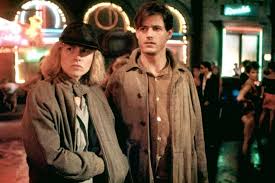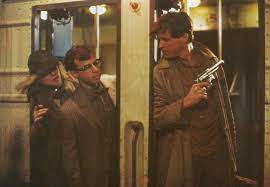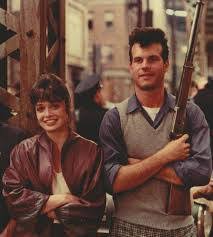STREETS OF FIRE (1984): A Rock & Roll Fable That Burned Bright and Bold

Released on June 1, 1984, Streets of Fire is much more than just a film; it’s a cult classic that uniquely blends the raw energy of 1950s rock-n-roll spirit with the gritty, stylized aesthetic of the 1980s. Directed by the visionary Walter Hill and co-written with Larry Gross, this action-packed neo-noir gem plunges viewers into a hyper-real urban landscape, often referred to simply as “The District.”
The film’s captivating plot follows ex-soldier Tom Cody (played with stoic cool by Michael Paré) and the tough-as-nails, resourceful sidekick McCoy (portrayed by the ever-impressive Amy Madigan). Their mission? A daring rescue of beloved rock singer Ellen Aim (a luminous Diane Lane), who happens to be Cody’s estranged ex-girlfriend. Aim has been kidnapped by the menacing biker gang leader Raven Shaddock, brought to terrifying life by a hauntingly intense Willem Dafoe in one of his early, memorable roles. The tension between Cody and Raven, fueled by their contrasting worlds, is palpable and drives much of the narrative.
The ensemble cast further enriches this wild ride, featuring recognizable faces such as the comedic genius Rick Moranis in an unexpectedly serious role as Ellen’s manager, Deborah Van Valkenburgh as Cody’s sister, E.G. Daily as a spirited band member, and a young, pre-fame Bill Paxton in a brief but memorable appearance. Together, they round out a roster of unforgettable characters inhabiting this distinct cinematic universe.
Though Streets of Fire didn’t find commercial success at the time of its release—earning only $8 million on a $14.5 million budget—its impact was far from fleeting. Over the years, it meticulously gained cult status for several compelling reasons: its highly stylized visuals, which bathed the screen in neon and shadows; its electric, genre-defying soundtrack, a powerful mix of rock, pop, and blues anthems (including hits like “I Can Dream About You” and “Tonight Is What It Means to Be Young”); and its unique, comic book-inspired storytelling.
With its iconic blend of leather, neon, and pulsating rock anthems, Streets of Fire remains a timeless cinematic love letter to rebels, romance, and redemption. It’s a film that eschews realism for a heightened reality, where style is substance and every frame pulsates with an almost operatic energy. Streets of Fire—still flickering with raw, renegade energy, captivating new audiences and beloved by those who first witnessed its bold vision.











